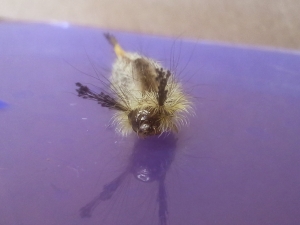The Douglas Fir Tussock Moth during seasons of severe outbreak often cause extreme defoliation of spruce, Douglas fir and other true fir species of evergreen trees. Damage starts at the top of the tree and trees encountering multiple seasons of infestation will receive substantial damage leaving them susceptible to bark and other fatal infestations. Over-wintering in the egg stage, caterpillars emerge in the spring around the time of bud break. Caterpillars will first consume new growth with older stages of the caterpillar further consuming needles, often stripping entire branches and causing death from the top of the tree working downwards. Tussock Moth caterpillars start off with a blackish colored body with long hairs that produce brightly colored hair tufts as they continue to grow. Larger larval caterpillars have a shiny black head, grey to brown body with an orange stripe down their side. Patches of brown hairs and red spots occur at the front and end of the caterpillar. Two long black tufts protrude from the head and another from the rear of the caterpillar. Adults emerge from the pupal stage cocoons in July and August. Adult female moths are wingless and have a thick body while adult males have rust-colored forewings and greyish colored back wings and have a wing span of only about an inch.
Aside from tree damage and potential tree death, another concern with Tussock Moth larvae is their larval hairs which can cause skin irritation. Reactions vary from slight rash and irritation to more severe reactions in some individuals and may necessitate medical attention.
Control is best obtained immediately after hatching; mortality agents may be applied starting at the tops of the affected trees. Many natural predators and parasites of the tussock moth area also present in Colorado and will typically bring populations back to normal levels within a few seasons, including birds, spiders, tachinid flies and several parasitic wasps. Outbreaks are common along Front Range communities; however native forest outbreaks are much less common. Spread most commonly occurs with the removal and movement of infested trees and wood containing egg masses and through the windblown movements of the wingless adult female moths.
